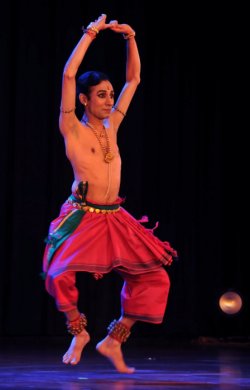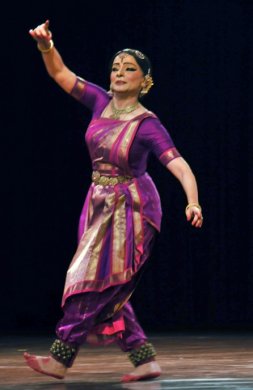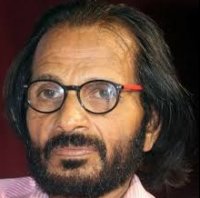
|   |

|   |
Random Recollections - V. Kaladharan e-mail: kaladh@rediffmail.com Photos courtesy: Music Academy January 25, 2020 Watching dance recitals incessantly right from the morning till late evening for a week strains one's eyes and enervates his/her mind however consummate the dancers and their accompanists are. But then the ambience of the Madras Music Academy makes all the difference. Save a handful of slumbering souls, the rasikas pay avid attention to the stylistics of each dancer and give instant feedbacks. Thus the prowess of each and every dancer is judged on the spot. This feature distinguishes the Music Academy dance festival from the more well-known and less known similar events in the rest of India. Although a bit too overwhelming, this year's dance festival could kindle my thoughts and impressions at multiple levels. Every accomplished young dancer can easily make out what made him/her endearing to the spectators. For Parshwanath Upadhye, it is undoubtedly the irresistible and infectious energy invested in his angikabhinaya central to the performance of a Varnam that catapulted him to something akin to a celebrity status. With a sprinkling of humour he often succeeds in ornamenting the image of Krishna in Padam that follows. Contrary to the expectation of the audience, Parshwanath's strengths, this time, were seldom revealed in the ada tala Varnam, Sarasijanabha, of the Tanjore Quartet. Sung in raga Kamboji, the pitch itself woefully lacked the requisite vim and vigour. Slow tempo and shortened jathis with the abhinaya devoid of colourful vinyasas made it dragging through and through. The witty and sprightly Parshwanath was unfortunately absent in the items to follow. Meera Sreenarayanan rose to the expectation of the audience when she displayed her virtuosity in the dance-segments of the swarajathi in raga Hussaini of the Tanjore Quartet. Right from the trikalajathi, she could win the rapt attention of the viewers. The range of the rupaka tala was fully explored in the swara and jathi portions while the lovelorn heroine's pangs of separation from her lover, King Prathapa Simha were eloquent in her upangabhinaya. Meera's face still exudes some sort of an innocence that might have added to her appeal on stage. The modulations in music besides the backing of Indira Kadambi on the nattuvangam added spice to her recital. A couple of years back, Alastair Macaulay, acclaimed dance-critic of the New York Times was at the Music Academy. We together watched with bated breath the brilliant dancer Rama Vaidyanathan whose grace of the angopangapratyangas complemented her involvement in Varnam and in the subsequent items. Watching her do a Padam punctuated by shades of humour, Alastair commented that Rama was one of the few dancers in whom he could find riveting traits of hilarity. Strangely, her recital this time did not elevate the spectators to uncommon heights. Unlike Krishna or Rama, Muruga or Ganesha as the protagonist in the dance repertoire does not offer tremendous scope for diversity of expressions. Hence when the dancer holds on to Muruga as a recurring motif throughout her concert, it becomes insipid for the prekshakas to a considerable extent. The magic of Rama's jathis springing from her absolute command over rhythm and the tempos and the fluency of her satwikabhinaya were found missing in the presentation of the famed Dandayudhapani Pillai Varnam, Swamiyai azhaithodi vaa. Priyadarsini Govind's meticulous sense of aesthetics was evident in her recital. Even though one could notice a perceptible deficiency of punch and expansiveness in the dance segment, her articulations in terms of the terse movement vocabulary and emotive acting were simply spellbinding be it in the Muthaiah Bhagavathar composition, Mate malayadhwaja or in the item humorously touching upon the pranks of Ganesha and Muruga in the presence and involvement of their mother Parvathi. Janaki Rangarajan attempted at providing a distinct flavour to her recital by presenting Saptatala Ragamalika Jathiswaram followed by the Varnam, Samika naatho in raga Manohari, compositions of the Tanjore Quartet. Janaki does have the courage of conviction and prowess to take up challenging items and present those with her stamp on the body kinetics and facial expressions. The dancer strikingly portrayed the sensuousness crucial to the relationship between Radha and Krishna exemplified in the lyrics, Kuru yadu nandana set to raga Behag. Had it been sanitized it would not have had the desired effect. Praveen Kumar accompanied on the vocal and instrumental music by a team of highly talented artists impressed the rasikas right from the very beginning. His approach to and treatment of each and every item presented including the Varnam, Mate malayadhwaja made all the difference. The distinctive tone of the adavus, the alluring texture of the jathis and an immaculate satwikabhinaya empowered by the music, both vocal and instrumental, were a delight to watch. With all the items set to adi tala, Praveen Kumar did not go in for any complex phrases. In other words, his spontaneous handling of each item with a visible simplicity had a profound impact on the audience. The outstanding young dancer Shewata Prachande's taste for choosing appropriate items and her unfading attention to the details of execution of the angika and satwikabhinayas made her recital an unforgettable experience for the beholders. The lyrics of Lalgudi's Varnam in raga Charukesi is unambiguous, forthright and beautiful. Therefore, the viewers could effortlessly read her involvement in the thematic moods interspersed with technical virtuosity. Both the dancer and the audience were on the same wave length and there was not even an iota of strain that marred the spontaneity of the recital.  P. Praveen Kumar  Malavika Sarukkai The festival once again underscored the fact that the two veteran dancers, Alarmel Valli and Malavika Sarukkai, remain unchallenged. Besides their empirical knowledge of the dance form and the ingrained sense of aesthetic nuances, musicality fundamental to their movement vocabulary easily distinguishes them from the rest. While Valli's musical sensibility is inextricably linked to the lyrics and is implicit in the entire gamut of her movements, for Malavika, it is manifest all over her angopangapratyangas. Valli's unfolding of the least known Telugu poem, Pushpavilapam, in visual phrases was innately poetic and musical to the core. The eco-sensitive message involved in the lamentation of the flower was conveyed to the audience in an inexplicably poignant tone. In the Swathi Padavarnam, Sumasayaka, Malavika zeroed in on 'time' as palpable as well as distressing for the virahothkhandita nayika. In contrast, for her Lord Padmanabha, 'time' is infinite and very much within his command. How the dancer here navigates from the concrete to the abstract, from the mundane to the non-worldly by means of the magical interplay of the angika and the satwika is simply breathtaking. The procession scene in the item, Aaparcchanam, which she delineated afterwards, involving the Khanda and Mishra Natas was delectable too. Almost all the dancers, young and middle-aged, who performed at the Academy, invariably possess the requisite qualities. Dancers like Jyotsna Jagannathan, Apoorva Jayaraman and Dakshina Vaidyanathan did captivate the audience. But then one hopes they would in the days to come cast a spell over the samajikaas with a spark either in their treatment of a character or a certain context in the Varnam/Padam or else in pushing the boundaries of the movement dynamics. On the music of dance, especially on the vocal, I reserve my reflections for the time being. The observations above are not at all deemed to be authoritative or exclusive. One can very well dismiss those as impressionistic, prejudiced and highly opinionated. I have no grievances whatsoever the readers make out of my musings.  Former Deputy Registrar of Kerala Kalamandalam, V Kaladharan is also an art critic. He has published several articles at the academic level. 'From Meditative Learning to Impersonal Pedagogy' was published a couple of years back in an anthology 'Qui Parley' initiated and released by scholars and writers from the University of California, Berkeley. His articles on Indian performing arts and literature regularly appear in magazines and journals, and in the Friday Page of The Hindu. |